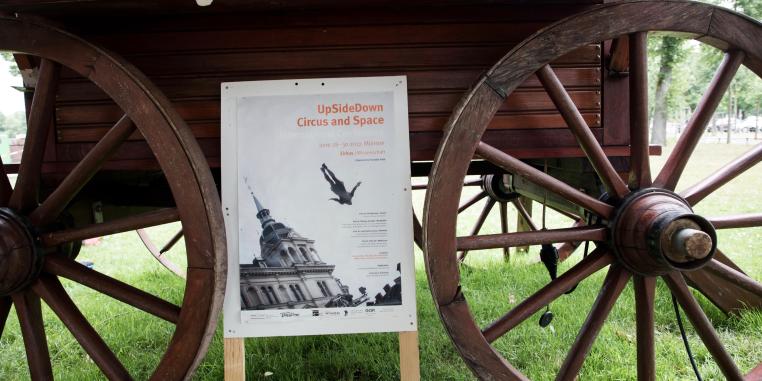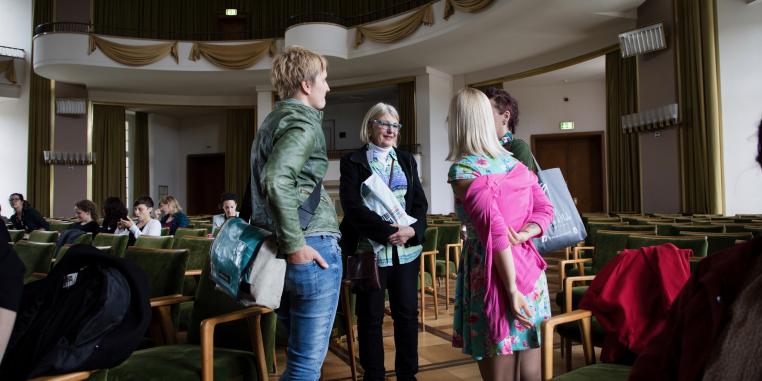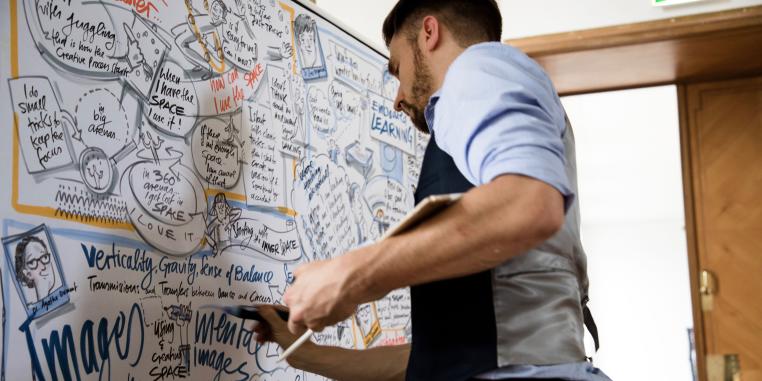





The space of the circus can be described and analyzed in terms of geometry and topology. These approaches apply to the variable surfaces it occupies when it takes over a portion of public or private space within which it inserts itself temporarily. Topology is relevant to the specific way in which the parts of the space occupied by the circus are related to each other irrespective of their particular dimension or abstract geometrical properties. Topology is the domain pertaining to the differentiation of values. It introduces the semantic dimensions that oppose the notions of in vs out, center vs periphery, figure vs margins, high vs low, profane vs sacred, territorial vs open, and the like. However, as interesting as this approach may be, there is nothing specific about this spatial conceptualization of the circus. This kind of analysis, both geometrical and topological, is relevant to practically all social institutions that are embodied in social space and imply continuous movements, step by step, for exploratory or transitory purposes.
The specific space of the circus is the four-dimensional space of gravity. This not an abstract consideration but, on the contrary, the very essence of its existence. It is the domain in which everything has weight and falls if it is not maintained in its stable position. In ordinary life, we take that for granted and we forget that the mere fact of walking is a constant loss and gain of balance. This paper will discuss the circus from the point of view of its verticality and the challenge that gravitation represents for survival on the planet earth. Gravity or gravitation (from the Latin gravis = heavy, serious) can be expressed by mathematical equations or, more concretely, by weights and measures, but it is also an existential condition which can be identified with the human condition itself. The circus is the node where all these factors merge to produce not only a physical and biological event, but also a deeply existential and symbolic experience.
Prof. Dr. Paul Bouissac is Professor Emeritus at the University of Toronto (Victoria College). His teaching and research bear upon semiotics and linguistics. He is the author of five books on the ethno-semiotics of circus spectacles. He has published and edited works on gestures, iconicity, non-verbal communication and prehistoric visual representations. He edited the Oxford University Encyclopedia of Semiotics (1998). He is currently Editor of the Bloomsbury Academic series “Advances in Semiotics”.
In 1950, Fernand Léger, enthusiastically exhorting readers to go to the circus, draws attention to the singularity of this aesthetic experience, especially regarding its architectural shape: “You leave your rectangles, your geometrical windows and you go to the land of circles in action. […] Roundness is free. It has no beginning and no end.” Such a praise articulates both the intuition of a perspective displacement due to the ring device and the fantasies which arise from it. Since then, the circus’ circle has never ceased being the subject of comments and aesthetic, if not ontological, disputes (is it essential to circus?). In these debates, two entangled topics collide: the spectacular effects resulting from the circular form invoke a political imaginary.
Some would say that the ring embodies the “perfect panopticon”, therefore taking part in the tradition of antique circus games and feeding the image of artistic bodies as sacrificed bodies—all exposed in a sort of arena where risk is central. This analysis is based precisely on the same point which leads others to argue that the ring is an eminently democratic architectural form: the so-called equal distance between each spectator and each action taking place in the centre of the ring allows a global view for everyone. But these conclusions are inaccurate: in the circus, each spectator sees alternately a portion of the action as artists wheel around. According to the spot chosen, one will have a better view of the tightrope walker or the swinging of the trapeze. When one takes a closer look at the spectator’s place in the circular device, it is precisely the piecemeal experience which is really shared by all. Far from a panopticon, it is rather a fragmentary world which can be seen. This observation and its aesthetical—therefore ethical and political—consequences will be questioned on the basis of spectacular analyses mainly from Johann Le Guillerm’s Secret, Fragan Ghelker’s Le Vide. Essai de cirque and Vimala Pons and Tsiriaka Harrivel’s Grande. What does the circular device produce?
Natalia Kloos decided to study philosophy and literature in France (Sorbonne Nouvelle and Panthéon-La Sorbonne) after going to a professional circus school in Brazil. During her first year as a graduate student, Natalia wrote a dissertation on the sublime and the grotesque in contemporary circus (under the direction of Danièle Cohn / Paris 1); and then decided to question the idea of a “circus art of living” (EHESS, under the direction of Marielle Macé). Kloos explored the artists’ discourses when it comes to risks and ways of life. She did a research residency in CNAC (June 2015) and is preparing her PhD project under the direction of Marielle Macé and Esteban Buch (CRAL/EHESS).
Calling primarily on theorists associated with the Frankfurt School and their contemporaries (Brecht, Adorno, Benjamin, Bloch, Eisenstein, etc.), my paper argues that by leaving the ring and entering into theatres, Contemporary Circus has all the formal and cultural elements to, as Walter Benjamin says, “innervate” its audience. Interestingly, many theorists and artists from the Frankfurt Era within the realm of critical theory and Marxism make offhand comments about circus. Most are positive. Adorno says that a single trick from a circus performer has the power equal to a complete work of art to transcend the audience. Ernst Bloch calls circus “the only down-to-earth, honest performance.” Though not an entirely explicit reference, Brecht calls for more sports in theatre, or an athletic art, a common categorization of circus. For Ernst Bloch, part of the honesty and innervating capacity of circus is rooted in the space in which circus was performed, a ring with no walls or barriers—a veneration of circus’ ability to allow people to enter their space regardless of origin. Bloch further praises circus for its peripatetic nature: he shows an admiration for circus’ ability to travel—seamlessly and, seemingly—without politics from space to space. This of course was all referring to traditional circus.
Employing the same Frankfurt era approach (i.e., circus theorists such as Peta Tait) and semiotics, this paper strives to investigate the ontological and epistemological changes which occur with the transition from ring to theatre. As a case study, I will analyze the show TRACES by the Montreal-based troupe, Les Sept Doigts De La Main, which was also influential in the United States contemporary circus scene (also an appropriate name when utilizing theorization of habit and innervation by Benjamin). Using this show as text, I argue that a theatre-based circus show, even more so than its ring-based predecessor, has the ability to act as a habit-forming Spielraum. It catalyzes innervation and what would be deemed a positive outlook on the world by Marxists and critical theorists of the first half of the twentieth century. This is primarily achieved through visible labor, which is directly connected to a cornerstone of circus, human exceptionalism. TRACES applies Brechtian techniques similar to Epic Theatre, as well as other techniques about which Brecht theorized but did not necessarily apply. A combination of repetition and invoking yet rejecting cultural understandings of circus and theatre is another syntagm within the innervating paradigm. Together this establishes a unique grammar and language specific to contemporary circus. In regard to its relationship to borders and the changing of space, from a ring to an often bourgeois theater, circus has been epistemologically transformed, and with the change from traditional to contemporary has ontologically transformed, and this paper will assist in the theorizing of this affect.
Ayal Prouser started performing in the circus on the professional level at age 16 when he toured with Circus Smirkus. Since then, he has been performing and coaching circus art professionally within the disciplines of juggling, double trapeze, group acrobatics and flying trapeze. Prouser is currently a graduate student in film and media studies at Columbia University, New York. His academic focus is split between a Foucaultian approach to queer spectator theory of cinema, and a Western philosophical approach to circus arts. At Columbia he is an Interdisciplinary Arts Fellow, a position within the School of the Arts tasked with the responsibility of fostering and catalyzing interdisciplinary work and synergy within the School of the Arts. Prouser continues to teach and to perform in the circus arts.

How is a performance space capable of affecting the meaning of the performance and the perception of the audience? How will the theatre and circus discourse change when their natural performative environments are altered, i.e., when circus is staged in a theatre and theatre takes place in a circus? In my paper I will attempt to examine the question of the space between circus and theatre through the lens of semiotics. I will focus on two key Czech theatre performances and on one circus performance which is widely considered to be the first Czech contemporary circus performance ever staged.
In 1974, the Czech actor, director and clown Ctibor Turba erected a circus tent in Letná Park in Prague, a location once used for the big tops of traditional circus companies. In this small, patched-up circus tent, the playwright placed a theatrical production entitled Clownery. This was perhaps the first time that circus poetics appeared on the Czech stage in such a sophisticated conceptual form. Even then, Ctibor Turba understood the circus tent and the circus ring as a purely theatrical space. The purpose of Clownery was to communicate the circus topic and form in a theatrical dramatization of individual clown characters. The director thus transformed the traditional circus area, i.e., the ring, into a theatre environment. The actors' actions thus transformed the ring of Circus Alfred into a theatre stage. For Turba the clown was a figure, character, type and theatrical material, a means to portray his notions of the essence of humanity. What is more, his productions featured the clown as an exaggeration of humanity, a truly metaphorical representation of human nature.
A procedure similar to Turba's was employed by the Forman Brothers Theatre in a production entitled Freak Show (2009), staged in a brand-new circus building. The production is a model example. In it, circus becomes a theatrical theme and the circus elements of the production become inspired by circus and its symbolism. In the productions of Clownery and Freak Show, the sign system of the circus is transformed into the sign system of the theatre. On the other hand, The Flow of Time (2004) takes place in a purely theatrical space with a frontally arranged stage. Director and company leader Pavel Šťourač spent years in search of a form which would allow him to merge circus and theatre. The production utilizes primarily as means of expression puppet and shadow theatre procedures as well as elements of nonverbal theatre, aerial acrobatics and artistic cycling. The lecture aims to introduce how Contemporary Circus productions blend circus and theatre aesthetics, how the sign system of the circus interacts with the sign system of theatre and how this leads to the enrichment of the meanings of these two close art forms.
Dr. Veronika Štefanová holds a PhD from the Department of Theatre Studies of the Faculty of Arts of Charles University in Prague, where she has explored contemporary circus as a dramatic art. She occasionally lectures at Charles University, at the Academy of Performing Arts in Prague or at Masaryk University in Brno. She conducted her academic research at the École nationale de cirque Montréal and at Sorbonne-Nouvelle in Paris. She was also involved in research projects focusing on circus and dance. She is the co-founder of the first Czech library dedicated to circus arts, which is part of CIRQUEON, an umbrella organization for the support and development of contemporary circus in the Czech Republic.